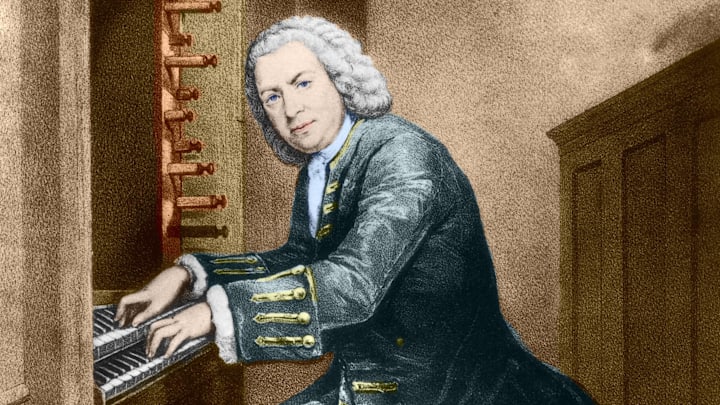Three days after Johann Sebastian Bach died from a stroke in July 1750, his body was laid in an oak coffin and hauled to a cemetery outside the city walls of Leipzig, Germany. Like many burials back then, no headstone was placed to mark Bach’s plot. Within years, the exact location of the composer’s grave had faded from memory.
Bach died a respected musician, but was by no means a superstar. That would change over the coming decades: An 1802 biography about his life—as well as a burgeoning interest in the musical works of the past—would launch him to the top of the newly formed classical music canon. Bach grew to become a source of national pride, and musical pilgrims worldwide were hungry to visit his grave to pay homage. In 1894, a group set out to find where, exactly, he was buried.
Rumor suggested that Bach’s corpse lay six paces from the south door of St. John's Church, but nobody was certain. “The oral tradition apparently originated in 1894 from a 75-year-old man, who in turn was informed about the location 60 years earlier by a 90-year-old gardener employed at the graveyard,” wrote Richard H.C. Zegers and several other scholars in the Medical Journal of Australia. Around that time, Pastor F. G. Tranzschel, the vestry chairman at St. John’s, ordered an excavation based on that information.
Bones of Contention
Dr. Wilhelm His, Sr., a Leipzig professor of anatomy, served as the dig’s leading egghead. As workers dug into the slop and mud of the church graveyard, His inspected the skeletons to see if the bones resembled those of a 65-year-old man. He described the scene as “heaps of bones, some in many layers lying on top of each other, some mixed in with the remains of coffins, others already smashed by the hacking of the diggers.” (To say the least, this was not history’s most scientific excavation.)
There was one telltale sign to look for: Most of the coffins in the cemetery were pine, but Bach’s bones were supposedly entombed in a casket of pricey oak. The crew found at least three such coffins. One contained a young woman (definitely not Bach), a second contained remains that had been smashed to splinters (hopefully not Bach), and a third contained a beautifully preserved skull (hallelujah?). In the words of musicologist and Bach expert David Yearsley at Counterpunch, Wilhelm His believed this skeleton “belonged to a man of distinction.” He studied the cranial cavity and even attempted to reconstruct the skull’s face, later claiming in a book that this “strange skull of very distinct and by no means ordinary forms” belonged to J.S. Bach. Shortly after, the skeleton was laid in a crypt below the altar of St. John’s Church.
But there was always a lingering doubt that His got it wrong. In 1949, Bach’s purported skeleton was exhumed and later reburied in St. Thomas Church in downtown Leipzig (where the composer once worked as Kapellmeister, or music director). Before this celebrated second burial, researchers decided to give the bones a second look. The skeleton was re-examined by the oral surgeon Wolfgang Rosenthal, who claimed to see proof of Bach’s identity not in the skull—but in a region, well, slightly south.
Rosenthal was intrigued by abnormal bony growths, called exostoses, around the skeleton’s pelvic ring, as well as growths at sites of muscle and ligament attachment, called enthesophytes, near the arms. Both are signs of occupational stress, common in physically active people who make repetitive motions day-in and day-out.
The Discovery of “Organist’s Disease”
Rosenthal wondered: Could a lifetime of organ-playing cause somebody to develop these bony growths? After all, an organist must regularly make awkward, repetitive foot and arm movements—especially if he or she practices a lot. To test his hypothesis, Rosenthal X-rayed the hips of 11 professional organists organists who, like Bach, had been playing since childhood. In a paper published more than a decade later, he claimed that all of them showed signs of the same bony growths as Bach's purported bones. Rosenthal came away convinced that not only had he re-confirmed the identity of the skeleton, he had discovered a new medical ailment: Organistenkrankheit, or organist’s disease.
Unfortunately for Rosenthal and fans of weird diseases with fun German names, the surgeon may have been mistaken. In 2007, researchers at the Academic Medical Center of Amsterdam tried to replicate Rosenthal's experiment, this time adding a control group of non-musicians. According to their report in the Medical Journal of Australia, of the 12 church organists X-rayed, only 33 percent had growths near the pelvis. Damningly, 75 percent of the non-organ-playing control group also showed an incidence of bony hip growths.
While the researchers admitted that their sample size was small, their work does appear to throw a wrench in Rosenthal’s hypothesis. “Our findings do not support the existence of Orgnistenkrankheit as a condition among organists,” the research team wrote. Furthermore, they concluded that “given the uncertainties about the burial site, His’s controversial facial reconstruction, and Rosenthal’s irreproducible Organistenkrankheit, it is unlikely that the remains are those of Bach.” Evidence, it seems, that hips really can lie.
Read More Fascinating Mysteries:
A version of this story was published in 2018; it has been updated for 2025.
